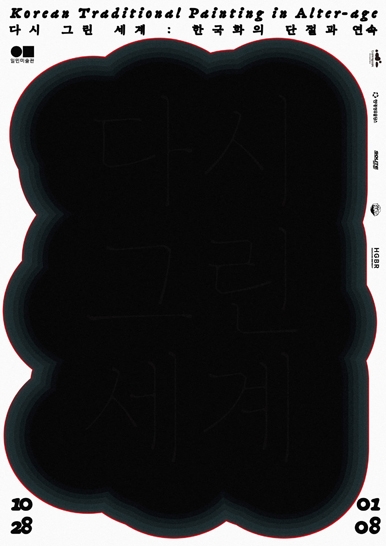‘한국화’는 한국 전통 예술에서 하나의 세계를 이루는 서화(書畵) 중 서(書, 글씨)와 구분하여 화(畵, 그림)를 지목한 것이다. 즉 한국화는 전통 예술과 구별되는 근대의 장르인 동시에 현대의 서양화와도 자연스럽게 이항 관계에 놓인다. 한국화라는 개념은 1950년대 이후 서서히 제안되어 1980년대 초반 사회 곳곳에 자리잡았다. 중국의 국화(國畵)나 일본의 일본화와 달리 포괄적인 동양화론을 받아들인 한국에서는 해방 후 제기된 식민 문화의 청산, 민족 정체성의 발견 같은 대의가 한국화 담론에 투사되었다. 이 과정에서 한국화를 둘러싼 연구는 과거의 유산을 계승하는 동력이자 민족이라는 기획을 고양하는 원천으로 기능한다.
《다시 그린 세계: 한국화의 단절과 연속》은 한국화를 이루는 주제와 재료, 표현 기법의 실험에서 참조될 수 있는 예술 작품을 모아 동시대 미술의 한 장르로서 한국화의 현재를 살핀다. 전시는 2000년대 이후 화단에 등장한 동시대 작가 13인과 함께, 미술관 소장품을 활용해, 전통 서화의 정점을 이룬 추사 김정희와 그의 계보를 잇는 예술가 22인, 겸재 정선을 비롯해 퇴계, 사임당, 율곡 등 ‘전통’이라 일컫는 체계에서 시간을 초월해 지표화된 인물을 소개한다. 이러한 구성은 한국화의 기반인 전통이 오늘날 어떻게 실재하는지에 대해 묻고 답하는 한편, 많은 부분 유실되어 사라진 전통의 총체를 연속과 단절이라는 양면을 통해 상상하기 위한 장치다. 여기서 모사와 참조, 수행적 변용으로 ‘다시 그려진’ 세계는 한국화가 미답의 수수께끼처럼 비워진 전통의 절단면을 매만지고 전승하는, 나아가 현실 위에 거듭 실현시키는 주요 방식이다.
근대의 보편적 성질과 한국의 특수한 지역성에 기대어 성립하는 ‘한국화’ 개념은 우리에게 내재된 현대의 감각과 긴밀한 관계를 맺는다. 한국화가 논쟁적으로 발전해 온 과정은 한국성을 표방하는 공동체가 굴절된 경험을 거쳐 독특한 모더니티를 재구성한 여정이었으며 《다시 그린 세계》는 그 결과 펼쳐진 혼성의 현대를 일련의 ‘다른 시대’(alter-age)로 가정한다. ‘다른 시대’는 패권적인 역사 담론이나 그에 대칭해 펼쳐진 탈식민주의 담론, 무한한 다원주의에 기반하는 동시대 담론 바깥에서, ‘스스로 풍부해지는’ 길을 통해 전통을 긍정하는 방편이다. 일민미술관은 과거와 현재를 망라해 한국화의 시각성을 드러내는 소장품과 현대미술을 그 근거로 제시하고 동시대 미술관으로서 우리가 당면한 미학적 현실을 새롭게 모색하고자 한다.
소장품
겸재 정선, 원교 이광사, 추사 김정희, 호산 조희룡, 소치 허련, 석파 이하응, 오원 장승업, 심전 안중식, 관재 이도영, 춘곡 고희동, 이당 김은호, 심향 박승무, 청전 이상범, 정재 최우석, 심산 노수현, 소정 변관식, 묵로 이용우, 소전 손재형, 고암 이응노, 월전 장우성, 운보 김기창, 남정 박노수, 산정 서세옥, 소정 황창배
Korean traditional painting refers to “hwa” (畵, painting) as distinct from “suh” (書, calligraphy) among “suh-hwa” (書畵) that make up a significant branch in Korean traditional art. In other words, Korean traditional painting is a modern genre distinct from traditional art and naturally, at the same time, a counterpart to modern Western painting. The concept of Korean traditional painting gradually developed in the 1950s and became established in various parts of Korean society in the early 1980s. Unlike the Chinese Guohua (國畵) or the Japanese Nihonga, Korean traditional painting accommodated a more comprehensive theory of Eastern painting, allowing for ideological causes such as “eschewing the remains of colonial culture from the Japanese occupation” and “recovering national identity” to enter the artistic discourse. Consequently, research around Korean traditional painting has a twofold motivation: to preserve the historical heritage and to sustain and elevate the interest of the Korean people.
Korean Traditional Painting in Alter-age showcases a collection of works representative of Korean traditional painting’s subjects, materials, and techniques to examine the present-day Korean traditional painting as a genre of contemporary art. The exhibition introduces 13 contemporary artists who emerged in the 2000s along with icons of Korean traditional painting―who have been championed “indices” in the construct of history―including Kim Jeonghui (the father of Korean calligraphy and painting), his 22 pupils in the museum’s collection, Jeong Seon, Yi Hwang, Saimdang Shin and Yi I. The show’s organization foments, on the one hand, an investigation of how Korean traditional painting abides in today’s art world and, on the other hand, an imagination of the big-picture tradition under the keywords “continuation” and “discontinuation” after parts of it has faded and perished. Here, the world is “re-imagined” through imitation, citation, and active reformation, which are crucial methods through which Korean traditional painting embraces, transcends, and, finally, re-presents the missing gaps, the empty sections in history that are like unanswered puzzles.
The concept of Korean traditional painting is founded on the general characteristics of modernity and the uniqueness of Korea’s locality combined. This concept is deeply connected with our contemporary sensibilities. The debated trajectory of Korean traditional painting’s development was a journey through which a community, upholding Koreanness, reconstructed modernity via its inflected experience and unique lens. Korean Traditional Painting in Alter-age imagines the resulting complex modernity to be a type of “alter-age.” “Alter-age” is a means to reaffirm tradition via “self-enrichment,” independent of the hegemonic historical canon, the decolonialist discourse, or the infinite pluralism theory. The Ilmin Museum of Art presents historical and contemporary artworks―from its collection and other sources―that demonstrate the qualities of Korean traditional painting. Further, the museum, as a contemporary art institution, aims to explore anew the reality today’s art faces.
전시제목《다시 그린 세계: 한국화의 단절과 연속》 Korean Traditional Painting in Alter-age
전시기간2022.10.28(금) - 2023.01.08(일)
참여작가
노한솔, 로랑 그라소, 문주혜, 박그림, 박소현, 박웅규, 박지은, 배재민, 손동현, 이은실, 정해나, 최해리, 황규민
관람시간11:00am - 07:00pm
*도슨트 프로그램
수, 토, 일 오후 3시, 각 회 40분 소요, 현장참여
휴관일매주 월요일 및 1월 1일 휴관
장르회화
관람료일반 7,000원
학생 5,000원(만 24세 이하 학생증 소지자)
장소일민미술관 Ilmin museum of art (서울 종로구 세종대로 152 (세종로, 일민미술관) 일민미술관 1, 2, 3전시실 및 프로젝트 룸)
주최일민미술관
후원한국문화예술위원회, 현대성우홀딩스, 환타, 한강주조
연락처02-2020-2055
